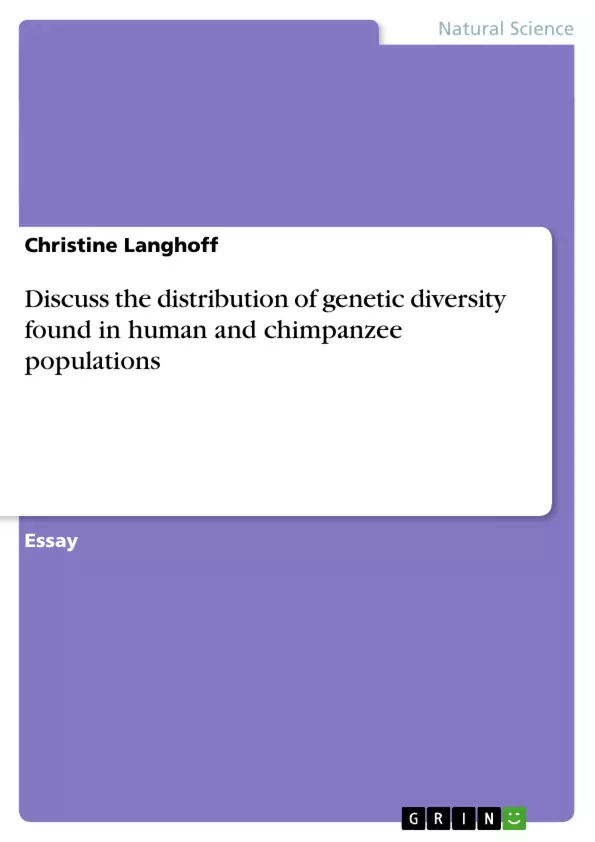In the mid-1980s one of the most important studies by Sibley and Ahlquist on our relationship to apes and monkeys found that our closest relatives are the chimpanzees and the bonobos. The study of genetic diversity within both human and chimpanzee populations has been of major interest as researchers have been and are still trying to find out about the differences in genetic diversity between the two otherwise so closely related species. The genetic diversity refers to the amount of genetic variation found in a population. It has been discovered that chimpanzees have a greater total genetic diversity than humans, but that there are exceptions such as in the major histocompatibility complex in which chimpanzees display a low genetic diversity. I am going to explore how the total genetic diversity is surveyed in and distributed among human and chimpanzee populations and I am going to compare their levels of total diversity. I am also going to explore whether different types of polymorphism reveal the same patterns of distribution within and among populations.
Inhaltsverzeichnis (Table of Contents)
- Genetic Diversity in Human and Chimpanzee Populations
- Methods of Studying Genetic Diversity
- Experimental Methods
- Statistical Methods
- Genetic Diversity in Human Populations
- Total Genetic Diversity
- Subdivision of Human Populations
- Genetic Diversity in Chimpanzee Populations
- Total Genetic Diversity
- Subspecies of Chimpanzees
Zielsetzung und Themenschwerpunkte (Objectives and Key Themes)
This work explores the distribution of genetic diversity in human and chimpanzee populations. It examines the methodologies used to study genetic diversity, focusing on both experimental and statistical approaches. The primary objective is to compare the levels of total genetic diversity between the two species, considering factors such as the major histocompatibility complex.
- Methods of studying genetic diversity in human and chimpanzee populations.
- Comparison of total genetic diversity between human and chimpanzee populations.
- Analysis of the distribution of genetic diversity within and among human populations.
- Examination of the role of the major histocompatibility complex in genetic diversity.
- Discussion of the concept of subspecies in chimpanzee populations.
Zusammenfassung der Kapitel (Chapter Summaries)
- Genetic Diversity in Human and Chimpanzee Populations: This chapter introduces the topic of genetic diversity and its relevance to the study of human and chimpanzee populations. It establishes the significance of comparing genetic diversity between these closely related species.
- Methods of Studying Genetic Diversity: This chapter delves into the methodologies employed for studying genetic diversity, encompassing both experimental and statistical approaches. It explores techniques such as electrophoresis, Polymerase Chain Reaction (PCR), and Wright's F statistics.
- Genetic Diversity in Human Populations: This chapter examines the distribution of genetic diversity within human populations. It discusses studies that have investigated the total genetic diversity in humans and whether humans can be subdivided into biologically defined groups.
- Genetic Diversity in Chimpanzee Populations: This chapter focuses on genetic diversity within chimpanzee populations. It explores the levels of total genetic diversity in chimpanzees, particularly highlighting the contrasting diversity patterns observed in the major histocompatibility complex.
Schlüsselwörter (Keywords)
This work focuses on the key concepts of genetic diversity, population structure, and comparative genomics. It delves into the methodologies used to study genetic variation, including electrophoresis, PCR, and statistical analyses like Wright's F statistics. The main themes revolve around comparing the levels of total genetic diversity in human and chimpanzee populations, examining the distribution of genetic diversity within and among human populations, and exploring the concept of subspecies in chimpanzee populations.
- Quote paper
- BA (Oxon), Dip Psych (Open) Christine Langhoff (Author), 2002, Discuss the distribution of genetic diversity found in human and chimpanzee populations, Munich, GRIN Verlag, https://www.grin.com/document/14020



